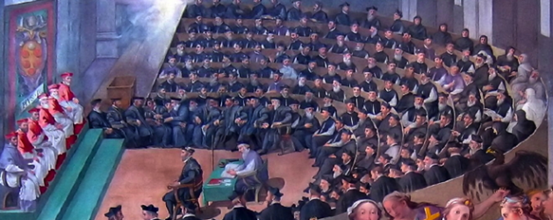To what extent does the Roman Catholic Church have the capacity to revise her dogma? Most of us in the evangelical world, informed by sixteenth century Reformation texts and teaching ministries such as Ligonier, need about a nanosecond to answer: “to no extent!” Of course it can’t. When a doctrine is de fide (of the faith), it is permanently cast in stone. The authoritative character of ecumenical councils produces immutable statements which are permanently imbedded in sacred Tradition. Here is how R.C. Sproul explains it:
The indisputable fact is that Rome made a number of strong, clear theological affirmations at the Council of Trent. Because Trent was an ecumenical council, it had all the weight of the infallibility of the church behind it. So, there is a sense in which Rome, in order to maintain her triumphant view of the authority of the church and of tradition, cannot repeal the canons and decrees of the Council of Trent. As recently as the Catechism of the Catholic Church at the end of the twentieth century, it made clear, unambiguous reaffirmations of Trent’s teachings. So, those who argue that these teachings on justification are no longer relevant to the debate between Protestantism and Roman Catholicism are simply ignoring what the church itself teaches. Yes, there are some Roman Catholic priests and scholars who dispute some of the teachings of their communion, but as far as the Roman hierarchy is concerned, the Council of Trent stands immutable on its teaching regarding justification. We cannot ignore what Trent said in evaluating where we stand in relation to the Roman Catholic Church and the ongoing relevance of the Reformation.
The notion that Rome doesn’t modify authoritative teaching such as the articles and canons of Trent is, with all due respect, out of step with reality. If you were looking for an example of a church that hasn’t changed for over a millennium, you’ll want to consider Eastern Orthodox Churches, not Rome. In the words of Calvin Scholar A.N.S. Lane, “The Roman Catholic Church, by contrast, has in the last generation changed more than the great majority of Protestant churches. This reality is often obscured by the Roman method of changing, which is not to disown the past but to reinterpret it. If we expect the Roman Church to disown Trent we will have a long wait; if we want to see Trent reinterpreted, we need only look around.”
Before looking specifically at Trent, let us consider what might be the most vivid illustration of how Rome modifies her doctrine. Ever since Pope Boniface VIII promulgated Unam Sanctam in 1302, the Catholic Church has unequivocally asserted that there is “no salvation outside of the [Catholic] Church” (extra Ecclesiam nulla salus). Boniface pressed the idea more vigorously than his predecessors by declaring that it is absolutely necessary for salvation that every human creature be subject to the Roman Pontiff. The less audacious version actually reaches back to Cyprian in the third century. It is among the most basic affirmations of the Catholic tradition and therefore it is employed with full authority; however, the meaning is now radically different from what it has been in previous centuries. You might say it’s a 180 degree difference. Read through the lens of Vatican II, it now means that sincere Buddhists and even atheists can be saved (Lumen Gentium 2:16; Gaudium et spes 22). The belief that God desires salvation to reach all people, coupled with the conviction that such redemption may occur through Jesus Christ apart from one’s conscious awareness, led Rome to develop her teaching on this point in a much different direction from what it originally seemed to say.
A tangible, if not dramatic, example of this sort of revision unfolded in Boston in 1949 (before Vatican II) when a zealous Catholic priest, Father Feeney of Boston, insisted on the traditional interpretation of extra Ecclesiam nulla salus (that only Catholics can be saved). After an extended period of warnings, Feeney was excommunicated by Rome as an obstinate rigorist. Thus, the church excommunicated a priest for holding a traditional interpretation, while it simultaneously asserted that the doctrine remains the same (semper eadem). This is how the Roman Catholic Church implements doctrinal revision: it retains the formulation while interpreting its meaning in a different light.
After the Council of Trent (1545-63), previous councils were naturally understood through the lens of Trent. The Tridentine grid became normative for Catholic teaching and remained such for four hundred years. Vatican I (1869-70) continued in the same vein. Then came Vatican II (1963-65) and a new interpretive filter was introduced. Where Trent stated that Protestants (who maintain sola fide and resist the authority of Rome) are lost, Vatican II introduced hermeneutical categories that call this conclusion into question.
So what about the notion that the Catechism of the Catholic Church unambiguously reaffirms the Council of Trent’s teaching? On one level it is right. The Catechism in paragraph 2011, for example, underscores the need for human merit (echoing the Council of Trent’s Decree on Justification, ch. 16). But it doesn’t stop there. It combines the Tridentine statement with a quotation by Saint Thérèse of Lisieux on the imperfection of our righteousness and our need for what we evangelicals call the forensic imputation of divine justice. Here is the entire paragraph:
2011 The charity of Christ is the source in us of all our merits before God. Grace, by uniting us to Christ in active love, ensures the supernatural quality of our acts and consequently their merit before God and before men. The saints have always had a lively awareness that their merits were pure grace.
[And as Saint Thérèse of Lisieux has said:] After earth’s exile, I hope to go and enjoy you in the fatherland, but I do not want to lay up merits for heaven. I want to work for your love alone. . . . In the evening of this life, I shall appear before you with empty hands, for I do not ask you, Lord, to count my works. All our justice is blemished in your eyes. I wish, then, to be clothed in your own justice and to receive from your love the eternal possession of yourself.
So what’s going on here? From a Catholic point of view, the inclusion of Thérèse’s statement effectively neutralizes Trent’s hard line. Examples of this sort of development of doctrine (or revision, if you like) can be multiplied. With regard to the doctrine of justification, it is the reason, for instance, why Pope Benedict explicitly affirms Luther’s phrase “faith alone” in his recent book on St. Paul[1] and why the Joint Declaration on Justification’s Annex endorses it as well. Does this mean that Catholics and Protestants now agree on justification and that the Reformation is over? No. Not even close. My point is simply to show that the Catholic Church’s method of developing doctrine works much differently from the way that popular evangelicalism usually portrays it.
Let me say two things by way of conclusion. First, I think the Catholic method of re-appropriating its doctrine through a developmental hermeneutic is problematic on an ethical level. Scripture admonishes us to be forthright when we’re wrong. Unfortunately, the Catholic Church has painted herself into a corner by investing magisterial conclusions with an immutable character such that she isn’t able to say, “We were wrong.”This is a problem.
Second, let me say why I believe this is a valuable lesson. Fruitful gospel witness among Catholic friends and loved ones requires us to portray them accurately. We evangelicals, for instance, know what it’s like when someone identifies us with proponents of the health and wealth message. It’s difficult to take such a person seriously, because he obviously hasn’t invested the time and effort to understand who we are. On the other hand, the people we most respect and listen to are those who avoid stereotypes, however popular or axiomatic they may be, and who make a sincere effort to comprehend us. This is our opportunity among Catholics. By understanding what the Catholic Church actually believes and practices, we will be in a better position to engage her in discussion about the good news of Jesus Christ.
[1] Pope Benedict XVI, Saint Paul. (San Francisco: Ignatius Press), 82





